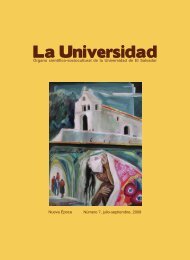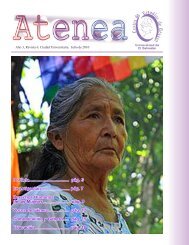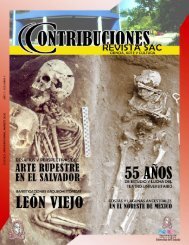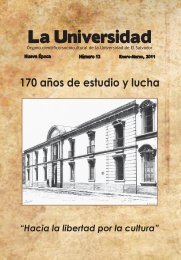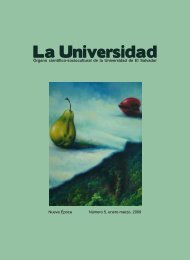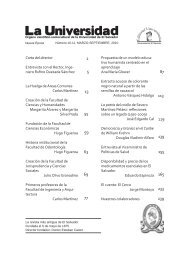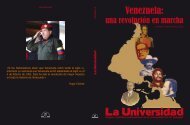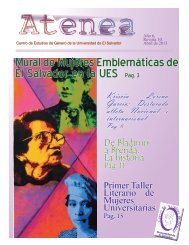Carta del director - Universidad de El Salvador
Carta del director - Universidad de El Salvador
Carta del director - Universidad de El Salvador
You also want an ePaper? Increase the reach of your titles
YUMPU automatically turns print PDFs into web optimized ePapers that Google loves.
nioc cultivation at a Classic Maya<br />
site.<br />
The ancient Maya village<br />
of Cerén is located in west-central<br />
<strong>El</strong> <strong>Salvador</strong> and is situated on<br />
a terrace west of the Río Sucio<br />
in the Zapotitán Valley [Sheets,<br />
2006]. The Cerén village was rapidly<br />
abandoned when the nearby<br />
Loma Cal<strong>de</strong>ra volcanic vent<br />
erupted approximately 1500 years<br />
ago (c. AD 590 SD 90). Within a<br />
few days to one week, the entire<br />
site was buried un<strong>de</strong>r multiple meters<br />
of volcanic ash, resulting in<br />
the unparalleled preservation of<br />
a Classic Maya site [Sheets, 2002].<br />
Since 1978 extensive archaeological<br />
research has been conducted<br />
at Cerén and the extraordinarily<br />
preserved structures, artifacts,<br />
and agricultural fields continue to<br />
profoundly contribute to un<strong>de</strong>rstandings<br />
of ancient Maya commoners<br />
[Sheets, 2002]. In addition<br />
to the agricultural ridges, furrows,<br />
and beds themselves, the impressions<br />
of plants have been preserved<br />
in the Loma Cal<strong>de</strong>ra ash at<br />
Cerén, so that precise replicas<br />
of the plants can be ma<strong>de</strong> by filling<br />
hollows with plaster [Sheets,<br />
2002]. Thus, individual plaster casts<br />
of plants document fine-grained<br />
<strong>de</strong>tail such as root size and shape,<br />
corn kernels, plant stalks, and<br />
even some leaves [Sheets, 2002,<br />
2009]. The plants that were grown<br />
216 La <strong>Universidad</strong><br />
at Cerén inclu<strong>de</strong> malanga (Xanthosoma<br />
sp.), maize (Zea mays),<br />
manioc (Manihot sp.), squash<br />
(Cucurbita sp.), cotton (Gossypium<br />
hirsutum), nance (Brysonima<br />
crassifolia), chile peppers (Capsicum<br />
annuum), hackberry (Celtis<br />
sp.), calabash fruit (Crescetia<br />
sp.), cacao (Theobroma cacao),<br />
and others [Lentz et al., 1996;<br />
Sheets and Woodward, 2002]. The<br />
emphasis here is on one cultigen,<br />
manioc, and the fields where it<br />
was grown south of the Cerén village<br />
center.<br />
Manioc is a bush that produces<br />
large roots with approximately<br />
five to ten tubers per plant.<br />
The plant favors areas with good<br />
drainage and less compacted<br />
soils [Cock, 1985; Hansen, 1983].<br />
The cultivation of manioc has long<br />
been hypothesized as potentially<br />
significant to ancient Maya diets<br />
for a variety of reasons: it has a<br />
high caloric content, it is relatively<br />
un<strong>de</strong>manding on the soil, and it<br />
tolerates droughts well [Bronson,<br />
1966]; Research involving the role<br />
of manioc in Classic Maya subsistence<br />
has suffered from the<br />
scarcity of direct evi<strong>de</strong>nce for its<br />
cultivation [Crane, 1996; Flannery,<br />
1982; Pohl et al., 1996; Pope et<br />
al., 2001; Miksieck, 1991: 180]. Given<br />
the ease with which manioc<br />
can be cultivated and its particular<br />
tolerance of poor soils and



